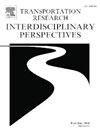Influential factors on speed reduction at vertical deflection devices in mixed traffic environments
IF 3.9
Q2 TRANSPORTATION
Transportation Research Interdisciplinary Perspectives
Pub Date : 2025-02-23
DOI:10.1016/j.trip.2025.101360
引用次数: 0
Abstract
Vertical deflection devices are widely implemented as traffic calming measures, designed to compel drivers to reduce their speeds to ensure a comfortable passage over them. However, these measures are primarily adapted from practices in developed countries, raising questions about their effectiveness in mixed-traffic environments. This study aims to investigate the factors influencing speed reductions in such contexts. The research focused on driver behavior while traversing three-speed humps and seven-speed tables located within a campus area. An Unmanned Aerial Vehicle (UAV) was employed to capture vehicle speed profiles as they navigated these devices.
2,101 speed samples were recorded, comprising 1,152 passenger cars and 949 motorcycles. Video recordings enabled the analysis of spot speeds at 10-meter intervals, starting 50 m before and extending 50 m beyond each device. Multiple linear regression analysis was utilized to identify the factors affecting speed reductions. The findings revealed that vertical deflection devices exerted a more substantial impact on reducing the speeds of passenger cars compared to motorcycles. Key factors significantly influencing speed reduction, ranked from most to least influential, included before-speed, vehicle type, device height, roadway grade, proximity to intersections, and roadway width.
These findings offer valuable insights for refining existing guidelines on the design and placement of vertical deflection devices in mixed-traffic environments.
混合交通环境下垂直偏转装置减速的影响因素
垂直偏转装置被广泛应用于交通镇静措施,旨在迫使司机降低速度,以确保舒适的通行。然而,这些措施主要是根据发达国家的做法改编的,因此对其在混合交通环境中的有效性提出了质疑。本研究旨在探讨在这种情况下影响速度降低的因素。这项研究的重点是司机在穿越位于校园区域内的三速驼峰和七速桌时的行为。一架无人驾驶飞行器(UAV)被用来捕捉车辆在这些设备导航时的速度曲线。记录了2101个速度样本,包括1152辆乘用车和949辆摩托车。视频记录可以分析每隔10米的速度,从每个设备前50米开始,延伸到每个设备后50米。采用多元线性回归分析确定影响减速的因素。研究结果显示,与摩托车相比,垂直偏转装置对降低乘用车的速度产生了更大的影响。影响降低车速的关键因素依次为前车速、车辆类型、设备高度、道路坡度、靠近十字路口和道路宽度。这些发现为完善混合交通环境中垂直偏转装置的设计和放置的现有指导方针提供了有价值的见解。
本文章由计算机程序翻译,如有差异,请以英文原文为准。
求助全文
约1分钟内获得全文
求助全文
来源期刊

Transportation Research Interdisciplinary Perspectives
Engineering-Automotive Engineering
CiteScore
12.90
自引率
0.00%
发文量
185
审稿时长
22 weeks
 求助内容:
求助内容: 应助结果提醒方式:
应助结果提醒方式:


